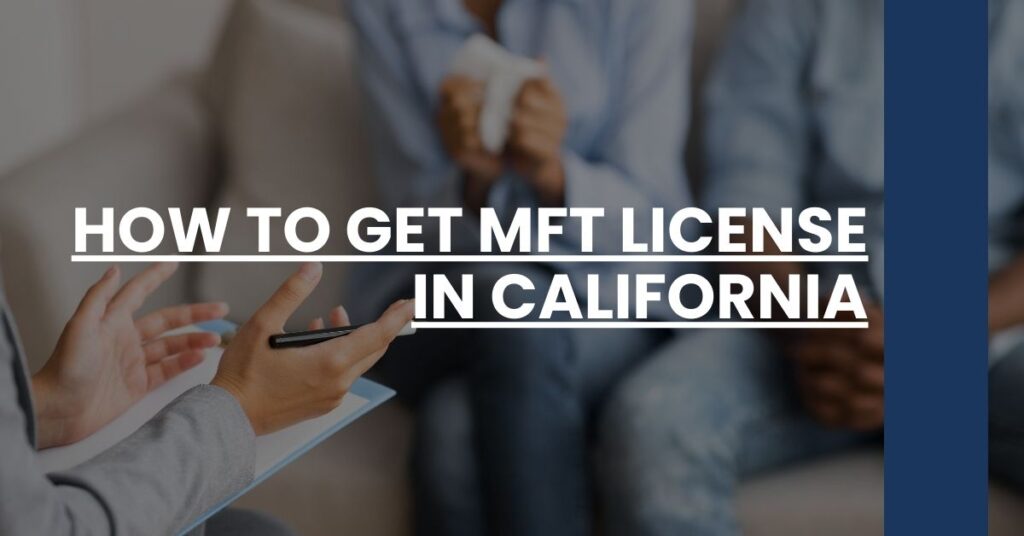How to get an MFT license in California just got clearer with our essential guide.
- Educational Requirements: Master your educational pathway with a qualifying master’s degree specific to MFT practice.
- Supervised Experience: Log the requisite 3,000 hours of supervised experience crucial for hands-on skills.
- Licensing Exams: Ace the California Law and Ethics and MFT Clinical exams to prove your expertise.
Start your journey on how to get an MFT license in California today!
- Understanding MFT Licensure in California
- Educational Requirements for MFT Licensure
- Registration as an Associate MFT
- Accumulating Supervised Experience
- Successful Completion of Licensing Exams
- The MFT Licensure Application Process
- Requirements for Out-of-State Applicants
- Renewing and Maintaining an MFT License
- Addressing Common Questions and Concerns
- Conclusion: Embarking on Your MFT Career
Understanding MFT Licensure in California
An MFT (Marriage and Family Therapist) license in California is not just a certification; it’s your gateway to impacting lives and nurturing family dynamics professionally. As an MFT, you’ll have the opportunity to aid individuals, couples, and families in overcoming emotional and psychological challenges. To begin your journey in this rewarding field, it’s essential to understand the value of being licensed and the recognition it garners within the Golden State.
Why is Licensure Important?
- Professional Legitimacy: It confirms your qualifications and your commitment to the high standards of the profession.
- Legal Requirement: In California, an MFT license is mandatory to practice legally.
- Trustworthiness: It assures clients of your expertise and adherence to ethical practices.
California-Specific Standards: California has unique requirements and benchmarks that must be met. Familiarize yourself with these California MFT licensure details to ensure you’re on the right path.
Educational Requirements for MFT Licensure
Becoming a licensed MFT starts with education. You’ll need specific academic qualifications that meet California’s exacting criteria.
- Earn a Master’s Degree: The degree should be from a recognized educational institution in a field related to marriage and family therapy, psychology, or social work.
- Accreditation Matters: Your program must be accredited by the Commission on Accreditation for Marriage and Family Therapy Education or equivalent.
- Course Content Requirements: Topics covered during your education must align with California’s prescribed educational guidelines.
For a detailed understanding of California’s educational prerequisites, review the Business and Professions Code sections on educational requirements.
Registration as an Associate MFT
After obtaining your degree, the next step is to become an Associate Marriage and Family Therapist (AMFT) in California.
- Application Submission: Complete and submit your application to the California Board of Behavioral Sciences (BBS).
- Take the Law and Ethics Exam: All applicants must take and pass this exam before accruing supervised hours.
- Supervised Experience: Begin accumulating relevant experience under a qualified supervisor.
Learn more about the journey of an AMFT in California to make sure you have all your bases covered.
Accumulating Supervised Experience
Hands-on experience is crucial. To qualify for full licensure, you’ll need a significant amount of supervised clinical experience.
- Complete 3,000 hours: 1,750 of these hours should be direct client contact.
- Duration: Accumulate these hours over a minimum of 104 weeks.
- Range of Experience: Ensure you’re gaining experience across different therapy modalities, client populations, and treatment settings.
Dive into the nitty-gritty of the supervised experience requirements for a better grasp on what’s expected.
Successful Completion of Licensing Exams
Passing your licensing exams is a testament to your mastery and readiness to practice. Here’s a step-by-step on how to navigate the examination phase successfully.
- Prepare for the California Law and Ethics Exam: This entails understanding the legal responsibilities and ethical considerations of practicing MFT in California.
- Study for the MFT Clinical Exam: A more thorough test, this assesses your competency across a broad spectrum of therapeutic issues and practices.
- Use Preparation Resources: Tap into study guides, practice exams, and preparation courses to bolster your readiness.
Find in-depth support and preparation materials to help you succeed on the MFT Clinical Exam page.
In navigating how to get an MFT license in California, each requirement propels you closer to the finish line of a fulfilling professional journey. Engage with the steps, appreciate the process, and envision the rewarding career that awaits you as a licensed MFT in the state of California.
The MFT Licensure Application Process
Navigating the application process for an MFT license in California can seem daunting at first glance. However, armed with the correct information and a systematic approach, you’ll find the path to licensure laid out more straightforwardly than anticipated.
Eligibility Checklist
Before delving into forms and fees, ensure you meet the essential criteria.
- Educational Requirements: Tick off the educational boxes with your accredited master’s or doctoral degree in a relevant field.
- Register as an AMFT: Confirm your status as a Registered Associate MFT in California.
- Supervised Experience: Document your 3,000 hours of clinical experience meticulously.
- State Examinations: Pass the California Law and Ethics Exam and the Clinical Exam to showcase your competency.
Completing the Application
Your attention to detail here ensures a smoother process and fewer potential hurdles.
- Gather Documents: Collect transcripts, proof of your degree, and detailed records of your supervised experience.
- Exam Results: Include the results of your required exams so the board can easily verify your passing status.
- Application Form: Fill out the LMFT licensure application with precision, ensuring all information is current and accurate.
- Application Fee: Pay the necessary fees, which contribute to processing your application and maintaining regulatory standards.
Tips for a Smooth Process
- Stay Organized: Keep copies of all submissions and correspondence.
- Follow Instructions: Adhere strictly to the instructions provided by the BBS regarding your application.
Requirements for Out-of-State Applicants
As an out-of-state MFT hoping to practice in the sun-soaked realm of California, you need to bridge the gap between your current licensure and California’s specific requirements.
Verifying Equivalency
Out-of-State Licensure Review: Show equivalence to California MFT licensure standards with your out-of-state license.
- Educational Equivalency: Your degree must be on par with California’s educational criteria.
- Clinical Experience: Hours accumulated must fulfill California’s extensive supervised experience requirements.
Discover how your out-of-state credentials measure up on the AAMFT’s state resources page, easing your transition to practice in California.
The Endorsement Process
Your out-of-state journey culminates with endorsement, formal recognition of your MFT qualifications in California.
- Supplemental Materials: Gather verification of licensure from each state where you have been licensed.
- Absence of Disciplinary Actions: Ensure that you have a clean professional record to present.
Renewing and Maintaining an MFT License
The lifecycle of your MFT license doesn’t stop at acquisition; it requires ongoing nurturing through continuous education and renewal processes.
Continuing Education (CE)
Stay Current and Compliant: Engage in 36 hours of CE every two years.
- Ethics and Laws: Among those hours, ensure at least 6 hours are dedicated to Law and Ethics.
- Diverse Learning: Participate in varied educational activities to retain and grow your therapeutic skills.
Dive deep into the renewal and maintenance policies on the California BBS continuing education page to stay ahead of the curve.
Compliance and Tracking
Regularly update your knowledge base and keep a record of all your CE activities.
- Record-Keeping: Maintain certificates of completion, as they’ll be indispensable if audited by the board.
- Adherence to Deadlines: Submit your renewal application on time to avoid any lapse in licensure.
Addressing Common Questions and Concerns
Let’s clarify those pressing concerns you might have about getting your MFT license in California.
Breaking Down Supervised Hours
- Clinical vs. Non-Clinical: Understand the balance between direct counseling and non-clinical work.
- 90-Day Rule: Get familiar with this rule that allows you to count supervised hours before your AMFT registration, once the application is submitted and approved.
Additional queries? The BBS FAQ section on MFT licensing is a treasure trove of clarity.
Supervisor Requirements
Your supervisor’s qualifications directly influence your journey.
- Clinical Competency: They must be certified and competent to offer clinical supervision.
- Training: Ensure your supervisor has the necessary training on California requirements.
Application and Approval Process
- Timeframe Expectations: Anticipate a 60-day processing time for applications.
- Communication with BBS: Establish a clear line for updates on application status.
Conclusion: Embarking on Your MFT Career
Understanding how to get an MFT license in California is more than jumping through hoops; it’s a strategic pursuit of your career aspirations. Take pride in every educational triumph, every clinical encounter, and every hurdle cleared. Many have navigated this path successfully, and now, it’s your turn to carve a niche in the vibrant field of marriage and family therapy in California.
Possessing your MFT license opens up a world where you can create significant, positive transformations in people’s lives. With your license in hand, the professional tapestry of California’s mental health landscape awaits, ready to be enriched by your unique skills and passion for healing relationships.
Learn how to get an MFT license in California: steps, education, exams, and supervision for a career in marriage therapy.

